Like any young and growing industry, the crypto space is in a constant state of flux. New projects are appearing all the time, each promising to solve a particular problem or revolutionise the industry in its own particular way. Meanwhile others, which promised much but delivered little, slowly fade into obscurity. It is a constant cycle of change.
Although it may seem to be all about the technology, crypto is no different to other industries in that it is shaped by personalities. We may get excited by a new project, platform or blockchain and what it claims to be able to do, but it is the people behind these enterprises that ultimately determine their successes or failures.

Dan Larimer: Hello ladies. Image via Medium
The truth of this was neatly demonstrated just a few days ago, when Block.one CTO Dan Larimer announced that he was leaving the company he helped to found. As many will know, Block.one is the company behind the EOS blockchain, and the news that Larimer had ‘left to pursue new personal projects’ caused the price of EOS to dip dramatically.
No matter what’s in the whitepaper, it’s still the brains behind these projects that matter the most. And, when it comes to crypto movers and shakers, few have a CV to match Dan Larimer’s.
Midas Touch
Since he first became aware of bitcoin back in 2009, Dan Larimer has put his formidable brain to work on a number of blockchain projects. He also has a legitimate claim to crypto OG status, having communicated directly with bitcoin founder Satoshi Nakamoto.
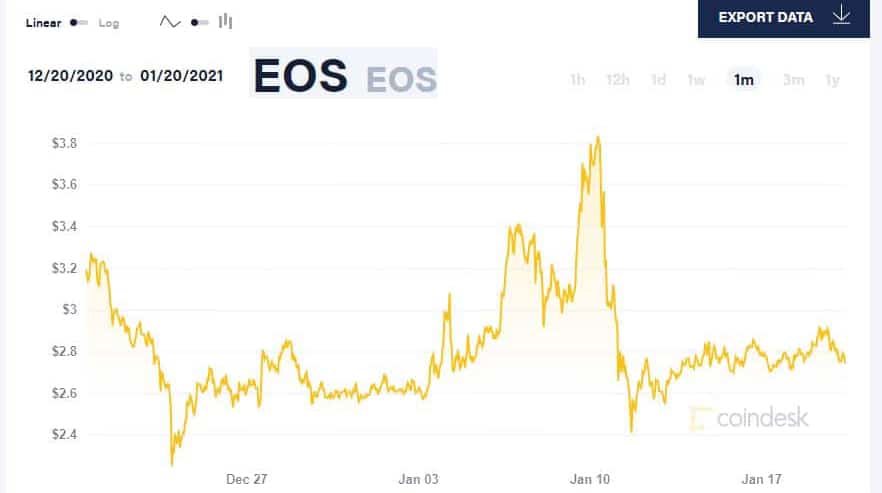
The EOS price nosedives following the announcement of Dan Larimer’s departure from Block.one on 10th January. Image via CoinDesk
What’s perhaps most noteworthy about Larimer’s blockchain career thus far, is that the projects he has built and subsequently walked away from have all been hugely successful. While many entrepreneurs often have a string of failures in their wake, Larimer seems to have a knack for breeding winners. This reputation for success largely helps explain the market’s alarmed response to his departure from Block.one.
In his statement that announced his parting of ways with Block.one, Larimer hinted at his future direction, saying:
I will continue on my mission to create free market, voluntary solutions for securing life, liberty, property, and justice for all. I do not know exactly what is next, but I am leaning toward building more censorship-resistant technologies. I have come to believe that you cannot provide “liberty as a service” and therefore I will focus my attention on creating tools that people can use to secure their own freedom.

Twitter gives Trump the Boot. Image via Twitter
Larimer, like many others in the blockchain space, including fellow old-schooler Nick Szabo, is concerned by the perceived erosion of free speech by all-powerful tech companies like Twitter and Facebook. It looks like his new direction is likely to focus on putting his experience with blockchain to work in fighting the giants of Silicon Valley.
But before we speculate further on where Larimer may be headed next, let’s look back over his remarkable career to date.
Beginnings
Dan Larimer was born in Colorado but grew up in Virginia, where he remains based to this day. In 2003 he received his Bachelor’s degree in Engineering from Virginia Tech, before going on to become a programmer in the defence industry.
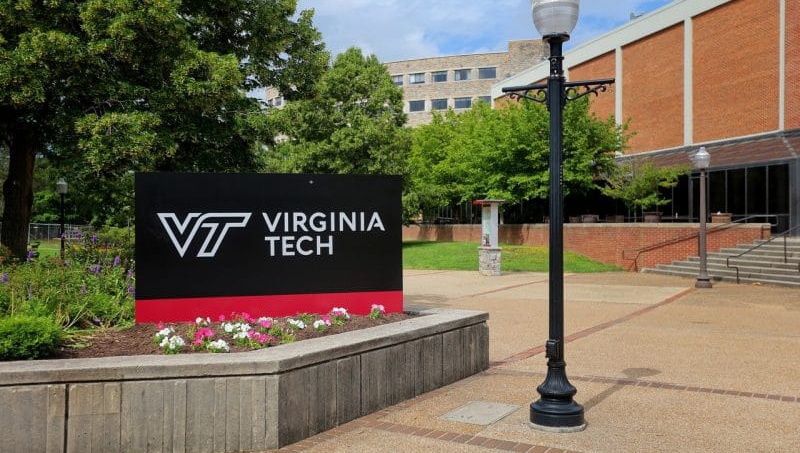
Virginia Tech University: Dan Larimer’s alma mater. Image via Virginia Tech News
By initially heading down this career path, Larimer was following in his father’s footsteps. Stan Larimer is no slouch in the brains department himself, having worked as a professor of rocket science (presumably the next level up from mere run-of-the-mill rocket scientist) at the US Air Force Academy. His son headed to the private sector however, working at Torc Robotics and Raytheon developing drones and autonomous vehicles.
It was while working in the defence sector that Larimer began to develop an interest in blockchain, before discovering bitcoin in 2009. This led him into forum discussions with the godhead himself, Satoshi Nakamoto. Larimer may not regard these discussions all that fondly, given that the most well-known part of their interaction is Satoshi’s sign-off to a discussion on bitcoin’s transaction speed that read, ‘If you don’t believe me or don’t get it, I don’t have time to try to convince you, sorry.’
Bitshares
Larimer finally turned his back on his defence career in 2013. ‘Philosophically,’ he said, ‘I wanted to move from working on weapons of destruction to creating systems that could help provide life, liberty and property for mankind.’ It was also around this time that he first outlined the idea of a decentralised autonomous organisation (DAO) in an article on the Let’s Talk Bitcoin Network.

Crypto wizard Charles Hoskinson. Image via CoinDesk
His research into bitcoin and blockchain led him to partner with another crypto legend-in-the-making, mathematician and future Ethereum and Cardano co-founder, Charles Hoskinson. Between them, Larimer and Hoskinson founded Bitshares, a cryptocurrency platform that showcased the delegated proof of stake (DPoS) algorithm that Larimer had invented. Hoskinson acted as the face and business side of the project, while Larimer worked away at developing the code.
Larimer’s libertarian credentials were also put into practice with Bitshares. He had long been uneasy with the power wielded by centralised exchanges, as well as their inherent vulnerability. As a result, Bitshares was designed to function as a decentralised exchange as well as a ‘stack of financial services including exchange and banking on a blockchain.’ It allowed for the purchase of market-pegged assets that many regarded as a vital hedge against crypto volatility.
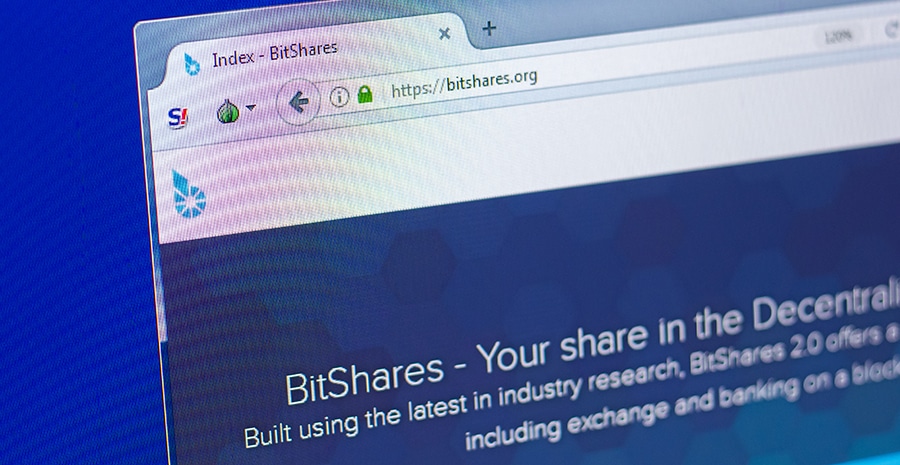
Image via Shutterstock
Not content with DPoS, Larimer also developed Graphene, an open-source blockchain implementation that would function as the foundation layer for Bitshares and later projects. Graphene is written in C++ and can process around 3,000 transactions per second, making it an ideal base layer for a platform like Bitshares.
As would happen with later projects, Larimer did not give Bitshares his full focus for long. But it was here, with DPoS and Graphene, that he laid the technical foundations for much of his later work. He spent two years with Bitshares, helping it achieve an impressive level of success, before deciding it was time to move on.
Cryptonomex
The next three years saw Larimer take entrepreneurship to new heights. Upon leaving Bitshares in 2015, he teamed up with his father Stan to found Cryptonomex, a company which ‘provides software development services to meet the growing demand for custom, high-performance, blockchains and related technology.’ Both Larimers saw the potential of blockchain and aimed to promote its adoption and growth.

Larimer V1.0 – Dan’s father Stan Larimer. Image via Crunchbase
Cryptonomex’s flagship product is OpenLedger, a blockchain architecture capable of processing over 100,000 transactions per second. In an echo of his role at Bitshares, Larimer Jnr was responsible for much of the code, while his father ran the business itself. Once again, having got the project up and running, Dan Larimer was off to pastures new.
Steemit
Barely a year after founding Cryptonomex, it was time for Larimer to take on the world of social media and bring it and blockchain together. The new platform, a decentralised application (DApp) called Steemit, would again make use of both DPoS and Graphene, while running on the newly-created Steem blockchain.
For this new project, Larimer teamed up with financial analyst Ned Scott to create a decentralised social network with a native currency (STEEM) to reward users and content creators. The pay-outs of STEEM are decided by the users themselves, who upvote posts they like and thus maintain an attention economy on the platform.

Steemit co-founder Ned Scott. Image via CoinReport
This philosophy stands in opposition to more mainstream social media platforms. In its own words, ‘Steemit believes that the users of the platform should receive the benefits and rewards for their attention and the contribution they make to the platform.’
Steemit has more in common with Reddit or Medium than with other social media platforms, though it makes itself unique with its system of rewarding those who participate in and use the network. The platform launched in 2016 and enjoyed some success, though a hack later the same year saw 260 accounts compromised and around $85,000-worth of STEEM stolen.
The STEEM token enjoyed some positive price action in the wake of its launch in July 2016, though the 2018 bear market saw it crash in value after peaking at over $8 dollars in January of that year. This price collapse resulted in around 70% of the company’s staff being laid off.
The token has flatlined since mid-2019 and now goes for around 20 cents. By the time of the price crash though, Larimer himself had – perhaps unsurprisingly by this point – moved on.
Block.one
Steemit can still be considered a success and it still attracts about seven million monthly visits. It may not be close to overhauling the centralised social media giants, but it remains one of the most popular blockchain-based networks.

Image via Startup Radar
Larimer quit as the project’s CTO in March 2017, moving on to what would become his biggest and most well-known undertaking to date. This time his collaborator was Brendan Blumer, another tech entrepreneur who clearly understood blockchain’s potential.
Blumer had founded his first company aged just 15, when he created Gamecliff, which facilitated the valuation, sale and exchange of in-game items in online games. The setup would be the same as with previous Larimer endeavours: Blumer would act as the CEO and face of the business, while Larimer took care of the geek side of things.
In a video introducing Block.one, Larimer describes the company as, ‘a publisher of open-source software. We make our software free and available for anyone to use to launch their own blockchains.’ Block.one is essentially a parent and holding company for a number of projects, the most prevalent of which is EOS.IO – the issuer of the EOS cryptocurrency. EOS ranks as the 17th most valuable crypto by market cap and launched in 2018 billed as an ‘Ethereum-killer’ smart contract blockchain.
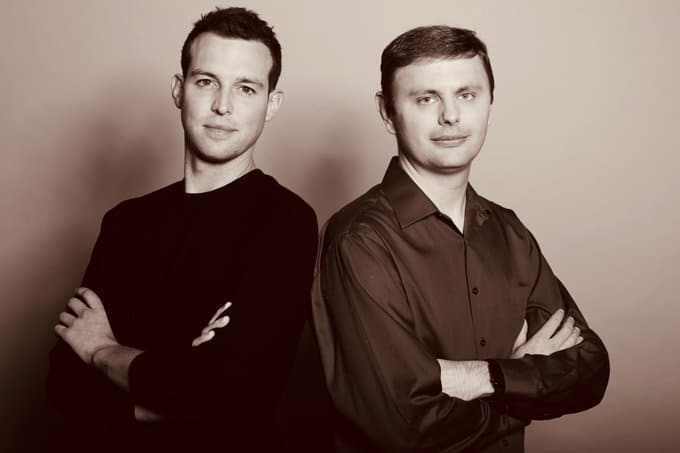
The likely lads: Block.one co-founders Brendan Blumer and Dan Larimer. Image via Twitter
The EOS platform is designed to allow developers to build DApps quicker and easier than they might on others – most notably Ethereum. As well as educational tools to help these developers, it also offers increased levels of scalability, making use once again of DPoS and Graphene for faster transaction throughput.
The other facet of Block.one is social networking platform Voice, which builds on Larimer’s experience with Steemit to function as another decentralised social network. When Larimer announced that he would no longer be using Twitter in early January 2021, he encouraged his more than 46,000 followers to follow him on Voice instead.
EOS Evolves
The EOS blockchain aimed to scale to potentially millions of transactions per second (TPS) and positioned itself as a direct competitor to Ethereum. Block.one also claimed that, alongside these millions of TPS, it had found a way to eliminate transaction fees on the network. This ambition attracted a lot of interest from investors and helped Block.one to raise over $4 billion in its yearlong ICO, which took place in 2018.

Image via Hacker Noon
This amounted to the largest ICO in history and allowed Block.one to forge ahead with the development of EOS.IO and the EOS blockchain, while also accumulating substantial reserves of bitcoin.
Since 2018, Block.one has adopted a hands-off approach to EOS, providing the software needed to launch the project, but leaving further development of it in the hands of its community. This separation may have been the reason why Block.one was able to get off relatively lightly when the Securities and Exchange Commission (SEC) came calling in 2019.

Blumer on Dan Larimer’s departure. Image via Twitter
The SEC accused Block.one of conducting an unregistered token sale during its 2018 ICO and fined the company £24 million dollars, Although this seems a hefty sum, it represents a tiny fraction the funds raised, while the SEC did not levy any other penalties on either Block.one or any of its employees. Contrast this with the recent Ripple lawsuit, which has seen the SEC go after both Ripple and three of its highest-ranking staff.
‘All good things must come to an end’
Dan Larimer’s exit from Block.one after a relatively long stint (for him) of three years has predictably caused quite a stir. We have seen how the EOS price took a hefty fall in the wake of his announcement, while some EOS holders have also reacted badly to the news, calling it ‘the last straw.’
Larimer had promised on several occasions that he was with EOS and Block.one for the long haul, a claim which should perhaps have been taken with a pinch of salt given his track record with the likes of Bitshares, Cryptonomex and Steemit.
Rather like Ripple co-founder Jed McCaleb, Larimer is seen by many as being incapable of seeing projects through, while others see him as little more than a pump and dump merchant.
Blockchain consultant Tone Veys is one such critic, saying:
Dan Larimer has started several proof-of-stake based projects and they have all been shady in nature… Both Bitshares and Steemit allowed insiders to create lots of tokens for themselves, and after that, the proof-of-stake nature of the project allowed those insiders to print tokens of value for themselves in perpetuity.
Yet although the frustration that many feel about this latest departure can be justified, it obscures the enormous contribution Larimer has made to blockchain and crypto. EOS may have disappointed many investors, but it remains one of the biggest cryptos around and may yet rally as Block.one regroups in the wake of its CTO’s exit.
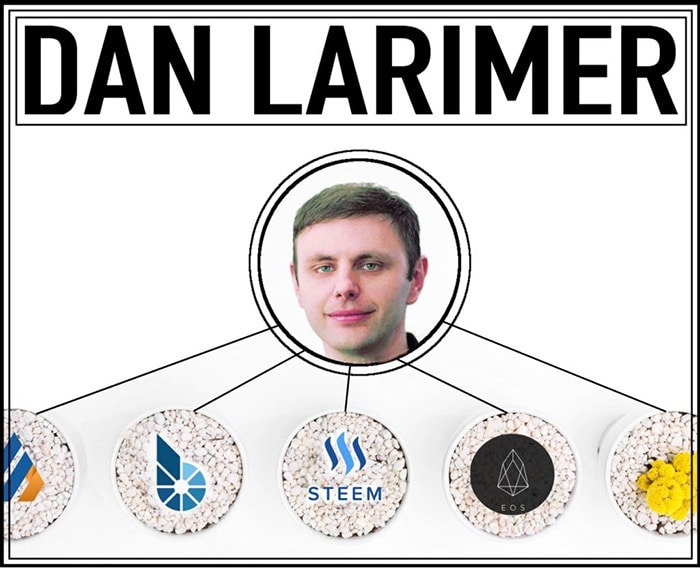
Dan Larimer’s Projects. Image via Hackernoon
If we look past the string of companies that Larimer has helped create, only to walk away from, we can see that he has always been more interested in the underlying technology of blockchain than of being any sort of public face for it. That has been left to the likes of Charles Hoskinson, Ned Scott and Brendan Blumer, while Larimer has devoted himself to building out the tech.
Thanks to Daniel Larimer we have DPoS, graphene and the DAO concept among many other contributions to the blockchain tech stack. Now, with these accomplishments behind him, he looks set to focus his energies elsewhere, with some of the biggest tech companies of all in his sights.
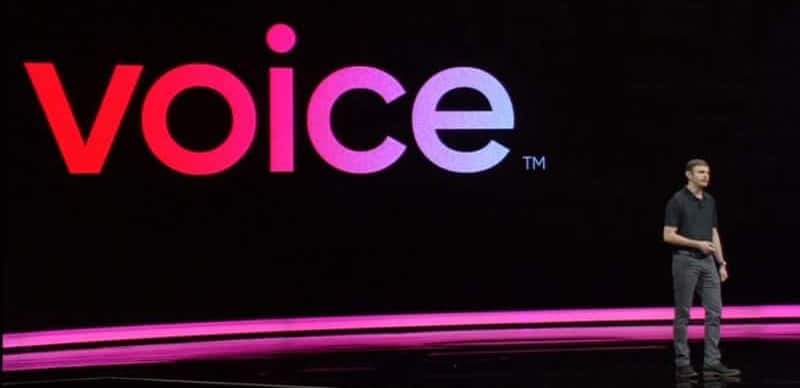
Daniel Larimer talks Voice at a Block.one event in 2019. Image via DeFi Republic
In a recent post on his blog More Equal Animals – The Subtle Art of True Democracy, Larimer took aim at the Silicon Valley hegemony, saying:
We are now facing a world where companies like Apple, Amazon, and Google are denying service to communities which share information and opinions that run counter to the prevailing narrative. The goal of this is to recapture control over the narrative. This goes far beyond censoring what people post on a companies [sic] own platform to denying others the ability to create their own alternative platforms.
It looks likely that the decentralised model of social media platform he pioneered with both Steemit and Voice may still be unfinished business for Larimer. His libertarian leanings, coupled with his unrivalled expertise, may be enough to have big tech looking over its shoulder.
Only a fool would bet against Dan Larimer making yet more vital contributions to blockchain and the crypto space, whatever path he takes from here.
Featured Image via Shutterstock
Source: https://www.coinbureau.com/analysis/who-is-dan-larimer/
- 000
- 100
- 2016
- 2019
- Action
- Adoption
- aged
- Air Force
- algorithm
- All
- Amazon
- among
- analyst
- announced
- Announcement
- Apple
- Application
- architecture
- around
- Art
- Assets
- autonomous
- autonomous vehicles
- Ban
- Banking
- Bear Market
- big tech
- Biggest
- Billion
- Bitcoin
- Block.One
- blockchain
- blockchain projects
- Blog
- build
- Building
- business
- Cardano
- care
- Career
- caused
- ceo
- change
- Charles
- charles hoskinson
- claims
- Co-founder
- co-founders
- code
- Coindesk
- commission
- Common
- Communities
- community
- Companies
- company
- consultant
- content
- continue
- contract
- Crash
- Creating
- Credentials
- crypto
- cryptocurrency
- CTO
- Currency
- DAO
- dapp
- DApps
- data
- day
- defence
- Demand
- develop
- developers
- Development
- DID
- dollars
- Early
- echo
- economy
- educational
- employees
- Engineering
- Entrepreneur
- entrepreneurs
- entrepreneurship
- EOS
- ethereum
- Event
- exchange
- Exchanges
- Exit
- Face
- facing
- Fees
- Finally
- financial
- financial services
- First
- Focus
- follow
- founder
- founders
- Free
- Freedom
- full
- function
- funds
- future
- Games
- good
- Growing
- Growth
- hack
- here
- history
- How
- HTTPS
- ICO
- idea
- image
- Including
- industries
- industry
- information
- interaction
- interest
- Investors
- IT
- July
- Justice
- latest
- launch
- lawsuit
- Led
- Level
- Liberty
- Long
- Mainstream
- Making
- man
- March
- Market
- Market Cap
- Match
- Media
- medium
- Merchant
- million
- Mission
- model
- Moon
- Most Popular
- move
- network
- networking
- networks
- New Platform
- news
- Offers
- online
- Opinions
- opposition
- Other
- partner
- People
- philosophy
- platform
- Platforms
- Popular
- Posts
- potential of blockchain
- power
- price
- Price Crash
- private
- Product
- project
- projects
- promote
- proof
- Proof-of-Stake
- property
- public
- pump and dump
- purchase
- raise
- rally
- research
- response
- Rewards
- Ripple
- robotics
- Run
- running
- sale
- Satoshi
- Satoshi Nakamoto
- Scalability
- Scale
- Science
- SEC
- Securities
- Securities and Exchange Commission
- Services
- set
- Share
- Silicon Valley
- smart
- smart contract
- Social
- social media
- social media platforms
- social network
- Social networking
- Software
- software development
- Solutions
- SOLVE
- son
- Space
- speed
- stake
- started
- startup
- State
- Statement
- Status
- Steem
- Stir
- stolen
- success
- successful
- system
- Systems
- Talks
- tech
- Technical
- Technologies
- Technology
- time
- token
- Tokens
- track
- transaction
- Transactions
- trump
- university
- us
- users
- Valuation
- value
- Vehicles
- virginia
- Voice
- Volatility
- vulnerability
- What is
- Whitepaper
- WHO
- words
- Work
- world
- year
- years
- youtube













